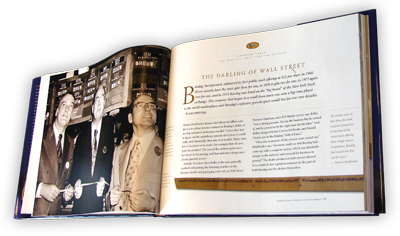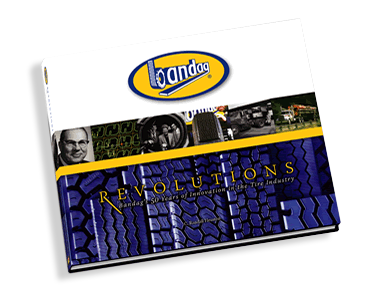
Some We’ve Worked With
• AAA Baseball
(Quad-Cities)
• Al-jon/Vezzani Corp.,
• Bandag Manufacturing
• Brand Central Station
• Burlington (IA) Chamber
of Commerce,
• Chiropractic Centennial
Foundation
• Dahl Ford
• Deere & Co.
• Dubuque (IA)
Development
Commission
• First Midwest Banks
• Galesburg (IL) Chamber
of Commerce
• Galesburg Economic
Development Corp.
• Illinois Association of
Public Health
Administrators
• Iowa Development
Commission
• Kartridg Pak
• Life University
• MidCoast
Communications
• Mod-Form Manufacturing
• MPA Media
• National Seal Co.
• Palmer Chiropractic
University System
• Quad-City Thunder
• Quad-City Times
• Quad-Cities Vision
for the Future
• Sears Manufacturing
• The Marketing Advantage
• The Residential Specialist
• Today’s Chiropractic
Lifestyle
• WDG Communications
• White Dog Studios
‘The World’s Most Trusted Retread’

The Darling of Wall Street
Bandag, Incorporated, submitted its first public stock offering at $12 per share in 1968. Eleven months later the stock split three for one, in 1970 it split two for one, in 1973 again two for one, and in 1974 Bandag was listed on the “big board” of the New York Stock exchange. The company that began in a small Iowa town was now a big-time player in the world marketplace, and Bandag’s explosive growth spurt would last for over two decades.
It was amazing.
Warren Heidbreder, chief financial officer, says the key to selling investors turned on Bandag’s ability to develop and prove its business model. “Carver first had to figure out the underlying concept, then prove it could really work financially, then take it to market. There were lots of decisions to be made. For example, how do you price the product? The cost of the cushion gum was a key factor in the pricing, and that and other things were closely guarded secrets.”
Actually, President Steve Keller is the man generally credited with putting the finishing touches on the business model and packaging it for sale on Wall Street. Chairman and CEO Marty Carver says Keller “was a strong presence. He ran the business like he owned it, and he proved to be the right man for the time.” And Keller, along with Roy Carver, Ed Brodie and Harold Vischer are in the Bandag “Hall of Fame.”
“Once the economies of the process were sorted out,” Heidbreder says, “investors could see that Bandag had come up with a complete system, which was absolutely unique to the industry and unusual for business in general.” The dealer production/sales model allowed for a relatively low capital investment on the part of both Bandag and the dealers themselves. “In certain ways, at least from the stock analysts’ perspective, at the time of the initial stock offering there simply was no competition. Bandag had roared into free market space.”
THE MEDIA dubbed Bandag “the darling of Wall Street” because, in contrast to the hand-to-mouth desperation of the early years, the publicly held company now consistently generated a strong cash flow with virtually no debt. Sales revenue grew dramatically, mirroring the volume of production.
Bandag was doing everything right. It added new dealers all over the world, then trained and supported them so that they mirrored the Bandag values and vision. At home, Bandag was a powerful force fighting for favorable legislation on issues like excise tax exemption for retreads and tire standards. Abroad, the company made wise decisions in opening new markets despite language, cultural and political barriers. The end users were always kept in mind, and they appreciated quality products that clearly added to their bottom line. A Bandag tire became exactly what one of the marketing slogans proclaimed: “The world’s most trusted retread.” And as Bandag grew, it gained business allies, the benefits of economies of scale, and market share.
Harold Vischer recalls that Barron’s magazine once described Bandag as “the money machine from Iowa. They said that a Bandag franchise was like a license to print money.”
“The reason we were better than everybody else,” says long-time Bandag manager Ron Seiler, “is that we had the whole process, and we set down very precise rules for it. We led the industry with specs, rules and standards—we could do that because we provided it all. We gave the dealers manuals and training second to none. And when radial tires came on the scene, our flexible envelope system could accommodate them. We were already way ahead of the game.”
Another thing that set Bandag apart from the competition, says Don Schauer, who edited the Bandagram, a magazine for dealers, was Bandag’s ability as a problem-solver. “If a fleet customer has a problem with a retread, we solve the problem; the other guys just suggest the fleet owner buy new tires.”
“OF COURSE none of this just happened,” Vischer says. “We worked very hard. I’d be traveling, sometimes two or three weeks at a time. I was gone over family birthdays, Thanksgiving, whatever. We made personal contact with 95 percent of the dealers. Well, nobody else did that; nobody worked as hard as we did.
“And we trained our salesmen to talk to the truckers, and the truckers would tell their friends. Then we’d collect testimonials from truckers all over the place, and use those in our advertising. We were, you know, selling service and information as well as a product. And we would reward the dealers with trips, and those guys, they’d buy rubber because they enjoyed the trips.
“The Lord helped me be a good salesman. Sometimes I’d be talking to a prospect and I’d pray to myself, and then I could see the conversation shift. Then I’d make the sale.”
In 1969, Bandag sales hit $20 million. In 1973, they had skyrocketed to $95 million, and Bandag was listed 909 on Fortune magazine’s list of top 1,000 U.S. industrial corporations. The following year Bandag was cited as “Growth Company of the Year” by the National Association of Investment Clubs; the award was based on three key factors—the company had been in business at least 10 years and publicly owned for five; it had sales, pre-tax profits and earnings growth rates of at least 10 percent; and it was out-performing other companies in its industry.
In 1976 sales reached $182 million. A decade later they stood at $370.3 million. In 1991 Bandag was placed on Fortune 500 list of largest industrial companies in the U.S. In 1996 Bandag sales had reached nearly $757 million, and Tire Distribution Systems, Inc., the newly formed, wholly-owned Bandag subsidiary comprised of five Bandag-owned dealerships, racked up an additional $366 million. Bandag was a billion dollar baby.
Of course, the investors loved it. Not only did the stock splits and stock price increases pump up the value of their investment, but they also rejoiced that Bandag had steadily paid quarterly dividends since 1976. In fact, 2006 was the 29th year in which Bandag increased its annual dividend rate; in 1976 it was $0.05, and in 2006 it was $0.335 per share or approximately $6.5 million. Bandag is in the top 2.5 percent of U.S. dividend-paying companies and has been consistently recognized by analysts as an outstanding dividend achiever.
A single share of Bandag stock purchased in 1968 at $12 would be the equivalent of 72 shares today at about $50 a share or $3,600, not counting what you would have made in dividends. Now, if you’d only bought and held just 1,000 shares in 1968….
You have to wonder how much of that success was envisioned by the board members who attended the first stockholder meeting at the Muscatine Hotel in 1971. They included Roy Carver, Lucille Carver, Eugene Seyb, Harold Vischer, William Cory, Steve Keller and Edgar Jannotta. They were pioneers and risk takers, and they, along with thousands of Bandag employee investors, enjoyed the fruits of their labors.
Editorial Samples »
» Advertising
» Health
» History
» Legal
» Music
» Personal
» Speeches
» Sports
Related Links»
Revolutions – Bandag's 50 Years of Innovation in the Tire Industry

